RBA Annual Conference – 2003 Three Australian Asset-price Bubbles John Simon[1]
According to modern economic theory—which holds that markets are efficient, i.e., that share prices reflect intrinsic values, and that speculators are simply rational economic agents intent on optimising their wealth—the history of speculation is a dull affair. In the world of efficient markets there are no animal spirits, no crowd instincts, no emotions of greed or fear, no trend-following speculators, and no ‘irrational’ speculative bubbles. Yet the activities of speculators down the ages appear to me to be richer, more diverse in motivation and extraordinary in result, than anything described by economists.
Chancellor (1999, p xiii)
1. Introduction
Stories of speculative bubbles and the ensuing crashes are fascinating. When reading through, for example, Extraordinary popular delusions and the madness of crowds by Charles Mackay (1980) one is left with the overwhelming thought, ‘how could rational people behave so?’ Cautionary tales based on the Dutch tulip mania are well known, yet bubbles continue to occur. Each generation seems to believe that ‘this time it will be different’. Railways, electricity and the Internet are all great technological advances that spawned great speculative excess.
The recurrence of speculative excess in widely differing environments suggests that it is, at base, a product of human nature. As such, Australia has had its fair share of speculative excess. This paper will examine three occasions when Australia has experienced asset-price bubbles: the land bubble in Melbourne in the 1880s; the Poseidon nickel bubble of 1969–1970; and the stock and property market bubbles of the late 1980s. These episodes cover property markets, mining stocks and stocks more generally; as such they provide a diversity of experience that a study of episodes in the stock market alone would miss. Mining stocks, for example, behave very differently to those of stocks more generally because of the inherent riskiness of the activity. The property market is different again.
Nonetheless, the choice of these episodes anticipates an important discussion: What exactly is a bubble and why do these episodes qualify? While we can all point to episodes that look like a bubble, actually tying down a definition, or categorising a given episode is much harder. I turn to that question now to provide a justification for why the particular episodes listed above have been chosen.
2. What is a Bubble?
One of the more common things said of bubbles is that ‘you know one when you see one’. Unfortunately this means different things to different people. Some economists do not believe that there have been any asset market bubbles – merely examples of unrealised expectations.[2] Others even suggest that periods of ‘irrational despondency’ are more common than periods of ‘irrational exuberance’.[3] There are numerous academic papers discussing whether certain episodes are, or are not, bubbles and there is no consensus in the literature.[4]
To answer the question posed I begin with a brief presentation of four famous bubbles; this serves to outline the data underlying this discussion. Section 2.2 then discusses previous academic writing on bubbles and their classification of various bubble episodes. I argue that most of these papers do not provide a satisfactory definition of bubbles. Instead, I propose a slightly different approach to identifying bubbles and provide a definition of bubbles based on that approach in Section 2.3. This definition forms the basis for calling the episodes selected in this paper ‘bubbles’.
2.1 Four famous bubbles
I start my definition using the following events: the South Sea bubble, railway speculation in the 19th century, the US stock market in 1929, and the Internet bubble on the NASDAQ. There have been many more speculative bubbles throughout history. Kindleberger (2000), Mackay (1980) and Chancellor (1999) provide informative reading for those interested in more details and examples. The examples presented here are intended to provide a representative rather than exhaustive sample.
2.1.1 The South Sea bubble[5]
The South Sea bubble primarily involved trading in the shares of the South Sea Company in 1720. This company was formed in 1711 by a group of merchants and given a monopoly on British trade with the South Seas – Spain's South American colonies – in exchange for taking over some British government debt. A problem was that Spain was unwilling to allow much British trade.[6] Thus, the actual trade involved in the company's activities was relatively limited. Rumours of trade agreements with the King of Spain helped fuel some speculation. The bubble was, however, based around a purely financial transaction.
In 1719 it was proposed that the entire British government debt would be privatised – holders of government debt would be offered shares in the South Sea Company in exchange for their debt. This arrangement offered a number of potential benefits: the South Sea Company was offering to refinance the debt at a lower interest rate, so the government would lower its interest costs; debt holders were being offered tradable equity securities in exchange for their non-tradable debt; and the South Sea Company was hoping to profit as the middleman. However, the South Sea Company also sought to improve its profit through other means. The South Sea Company inflated the price of its shares in the market and then offered debt holders shares whose market value was higher than the value of their debt holdings but whose nominal value was much lower. The company made easy credit available to shareholders: shares were offered for sale on 20 per cent deposit, effectively lending the remaining 80 per cent, the money gained through this offer was used to offer loans to existing stockholders (secured against their stock) who wished to buy more stock. This served both to increase demand and reduce supply as shares used to collateralise loans were held by the company. These activities look much like a pyramid scheme where money from early investors is used to attract further investors. In addition to offering loans, demand was further stimulated by announcing an increase in the dividend payable.[7]
The South Sea bubble occurred over about 7 months in 1720. Company shares are reported to have risen from £130 on February 1 to around £1,000 on August 1. The rise in South Sea Company shares helped to fuel a more general speculative fever in England. Across the Channel, John Law's Mississippi scheme, whose general principles were copied in the South Sea scheme, had caught the French imagination. Companies were floated in Exchange Alley with dubious business plans. The accounts in Mackay (1980) and Chancellor (1999) suggest that many companies were started merely to raise capital from speculators and then abscond with the cash. The most famous of these is the, possibly apocryphal, ‘company for carrying on an undertaking of great advantage, but nobody to know what it is’.[8] The FT Actuaries All-Share Index provides a picture of the price movements at this time (Figure 1).
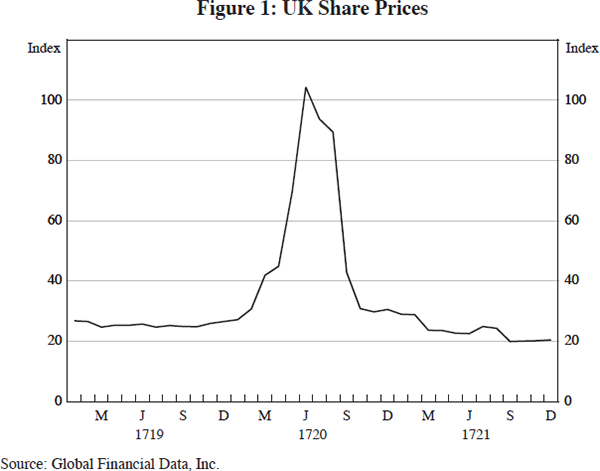
The index shows that overall stock prices rose almost four-fold in as many months. Nonetheless, like all bubbles, the collapse was just as rapid; from a peak of over £1,000 at the beginning of August, shares in the South Sea Company fell to £580 on September 12 and £150 on September 30. The general index mirrors these movements.
The simplest reason for the crash is that the pyramid scheme collapsed when new investors slowed and the principals started selling up. The fraudulent activities of many of the fringe companies also soured investors on stocks in general. Subsequently, parliamentary enquiries were established and many of the directors of the company convicted of various fraudulent activities.
2.1.2 Railway mania[9]
Railways represented a revolutionary technological innovation. They allowed large quantities of goods or passengers to be transported quickly and efficiently between previously isolated areas. This advantage meant that there was a great amount of real profit to be made by either companies who used railways or companies who owned them. Initially, at least, it was the railways that captured the profits. Only later, when there was over-capacity, did the profits accrue to railway users.
There was an outbreak of speculation associated with the opening of the first railway, the Stockton and Darlington, in 1825, but the major mania occurred some 20 years later. In the early 1840s railways captured the public imagination. Queen Victoria was persuaded to take her first railway journey in 1842 and, reportedly, found it quite pleasant. But much of the attention was generated by George Hudson, a particularly energetic entrepreneur who, in 1844, controlled over one-third of all the track in operation in the UK.
George Hudson engaged in some dubious and outright illegal practices in the process of promoting his railways: his company accounts were poorly maintained and, on occasion, fictitious; he paid dividends out of capital; and he intertwined his personal and corporate dealings, thereby extracting considerable personal gains.
The railway mania experienced its zenith in 1845. At the beginning of the mania, established companies were doing quite well – the three largest were paying dividends of 10 per cent, well above the more normal 5 per cent.[10] There was a surge in the number of new railways proposed. There were public solicitations for stock and a profusion of publications on railways, all of which served to feed the public's appetite for railways. In Scotland, banks were formed to provide loans of up to 80 per cent against the security of railway shares. Many people are reported to have signed up for share floats with no intention or ability to pay for the shares – they intended to resell the shares before any money was due. Contemporary commentaries highlighted the speculative rather than fundamental nature of investors: ‘There is not a single dabbler in scrip who does not steadfastly believe—first, that a crash sooner or later, is inevitable; and, secondly, that he himself will escape it’.[11] Chancellor reports that some shares rose by around 500 per cent over the course of 1845. The UK railway index suggests that the overall rise was milder – prices doubled in the up-phase (Figure 2).
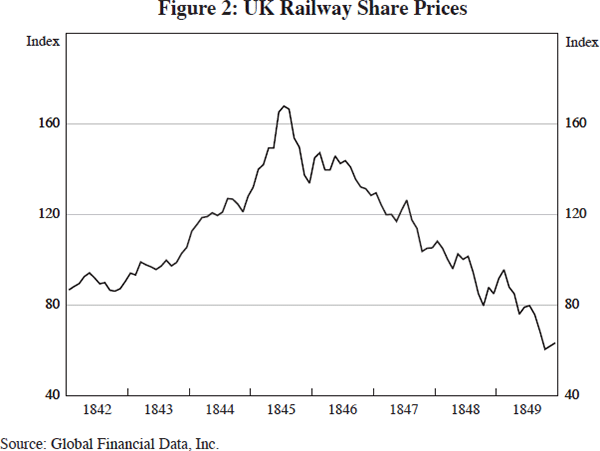
The bubble burst in October of 1845. In part this was the inevitable collapse of the fraudulent schemes that had survived on, and fuelled, the bubble. In part it was because most shares had been issued on a partly paid basis and further calls on investors were required when railway construction actually began. To come up with the capital some speculators liquidated their assets, which, in turn, placed further downward pressure on share prices. While many railway companies collapsed, others continued and contributed to a large over-capacity that kept railway shares depressed for many years to come.
2.1.3 The US stock market in 1929[12]
The 1920s was a decade of great optimism. Much was made of the fact that the US was enjoying a new economy based on improved business methods. The founding of the Federal Reserve in 1913 led to predictions of the death of the business cycle. New technology, in the form of the motor car, aircraft and radio, was seen to herald a new era. In sum, these technological innovations, not for the first or last time, contributed to a feeling that the old rules no longer applied.
As with previous bubbles, credit was relatively easy to obtain and, in particular, margin loans were very popular among stock investors. Wigmore (1985) calculates that margin loans amounted to about 18 per cent of market capitalisation in October 1929. On the corporate financial front, there was a trend towards retaining more earnings in companies to expand operations as well as the use of increased debt to finance expansion. In this environment old valuation methods, based on dividends, became increasingly difficult to use and ‘warranted’ prices relative to dividends rose.
In this environment of general optimism, and on the back of popular enthusiasm and speculation, stock prices rose. The Dow Jones rose by 75 per cent from around 200 to around 350 in a little over a year between July 1928 and August 1929 (Figure 3).
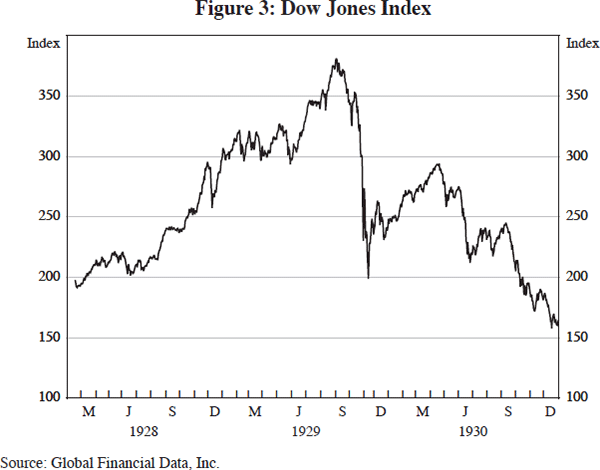
Eventually, the growth in stock prices stopped and, shortly after reaching its peak (September 3), the stock market crashed on October 28. There was no readily apparent cause for the crash and further weakness took the index back below 200 in around a month. There was a brief rally from there but the index generally trended down for the next couple of years. At the depths of the Depression in 1932 it traded near 40.
2.1.4 The Internet bubble
In the more recent Internet bubble there were many features similar to the railway mania and 1929 bubble. The new economy and the benefits of new technology were touted. As documented by Cooper, Dimitrov and Rau (2001), the simple addition of dot com to a company's name was sufficient for it to become the object of speculation. The unusually long expansion through the 1990s was taken as evidence that the business cycle had been tamed. Indeed, some people claimed that, over the long run, shares were a safer investment than bonds – an idea that had also been in vogue just before the 1929 crash.[13] The rise in tech-stocks was frequently justified by claims that the old rules of business no longer applied to these firms – a surprisingly familiar refrain. In particular, because few of the firms involved had ever paid a dividend, traditional valuation methods could not support the prices being paid for the stocks. Companies with the vaguest business plans were floated on stock exchanges at huge premiums to the underlying capital. Tech stocks generally reached remarkably high prices – Amazon.com was valued at US$26 billion at the end of 1999, approximately 10 times the combined value of their traditional ‘bricks and mortar’ competitors, Borders and Barnes and Noble.[14]
The clearest measure of the bubble is given by the tech-heavy NASDAQ stock index. Graphing the NASDAQ against the S&P 500 index shows that both grew at around the same rate from 1995 to late 1998. Figure 4 suggests that the bubble may have started around the beginning of 1999 and enjoyed its greatest growth from November 1999 to the middle of March 2000, over which time the NASDAQ index grew by 70 per cent.[15]
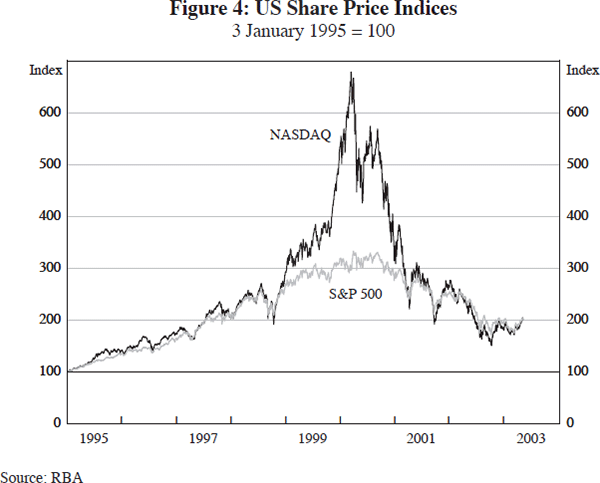
The collapse of share prices from March 2000 was fairly rapid and, as with 1929 before, there was no obvious real trigger for the collapse.[16] By March 2001 the NASDAQ was again level with the S&P index and has remained there since.
2.2 Bubble literature
Starting from basic theory, the value of an asset should equal the discounted flow of future income flows. Thus, for stocks, their ultimate value is determined by the flow of dividends they produce. This principle can be used to determine if asset prices are behaving oddly by looking for periods when the stock price becomes misaligned with the dividend stream that supports it. Unfortunately, a problem with this approach is that what really matters are future dividends and these can not be observed ex ante. Instead, assumptions about future dividend growth and interest rates need to be made. If these assumptions turn out to be wrong, ‘rational’ prices can be very different ex ante and ex post.
Some initial work in this area was by Shiller (1981) who claimed that there was evidence that stock market values could not be justified on the basis of future dividend flows – implicitly suggesting that bubbles might be present in share prices. Later work has questioned his findings on economic and econometric grounds. In general, evidence of bubbles is difficult to find via this route because various econometric issues muddy the results. Abstracting from econometric issues, small changes to assumptions can justify a wide range of stock prices – finding truly irrational prices is therefore quite difficult. Thus, despite being the avenue of most intensive research, this approach has been unable to give unambiguous conclusions. The case against bubbles is best put by Flood and Hodrick (1990), ‘It is our contention that no econometric test has yet demonstrated that bubbles are present in the data. In each case, misspecification of the model or alternative market fundamentals seems the likely explanation of the findings’.
Partly in reaction to this, there is a literature that looks for other testable implications of bubbles. These can be divided into two groups, those that look for a measure of fundamentals and those that examine the statistical properties of returns. However, in order not to raise your hopes about this literature, a reasonable summary of the state of play was given by Miller (1990, p 37) when he said – ‘Here, as all too often in economics … we are faced with competing theories that can seemingly account for the same facts and we have no way of conducting decisive experiments that can distinguish between them’.
McGrattan and Prescott (2001a, 2001b) look for departures from a fundamental measure of asset values. They define a bubble by reference to the q theory of investment – a set of assets should be worth the sum of the values of the individual assets. They conclude that the 1929 stock market was undervalued. In a similar vein, DeLong and Shleifer (1991) look at the value of closed-end funds (a particular kind of managed fund) relative to their underlying stock holdings and, in contrast, conclude that there was a bubble in 1929. Rappoport and White (1991) identify a bubble by looking at the risk premium embodied in loans to stockbrokers. They find that this risk premium increased markedly in the 1929 stock market and thereby infer the presence of a bubble. A problem with using these approaches is that they rely on particular institutional features of the US stock market, and could not easily be applied to other asset markets.
In contrast to the fundamentals-based approaches, Santoni and Dwyer (1990) identify a bubble as a period when stock market returns do not follow a random walk, i.e., there is a departure from the efficient markets hypothesis. Using this definition they claim that neither 1929 nor 1987 were bubbles. However, Warman (1990) points out that their test is not a useful discriminator because it identifies some non-bubble periods as ‘bubbles’. In somewhat of a mix of the two approaches, Siegel (2003) proposes a definition of a bubble as one where the 30 year future returns from holding stock are more than two standard deviations below the average. Using this definition he finds no evidence of bubbles in the past 120 years in the general US stock market. Monte Carlo experiments on Siegel's test suggest that it suffers from low power – it misses most bubble episodes while also identifying non-bubble episodes as bubbles.[17]
Given the conflicting set of results coming from empirical tests it would seem that views about the existence of bubbles come down to personal judgements. At one extreme is Peter Garber. He proposes that: ‘Before economists relegate a speculative event to the inexplicable or bubble category, however, we must exhaust all reasonable economic explanations … our methodology should always require that we search intensively for market fundamental explanations before clutching the “bubble” last resort’ (Garber 1990). He then claims that fundamentals could support the prices paid during the tulip mania, the Mississippi scheme and the South Sea bubble.
By contrast, other economists view it as self-evident that bubbles have periodically occurred. For example, Shiller (2003) defines a bubble as ‘a period when investors are attracted to an investment irrationally because rising prices encourage them to expect, at some level of consciousness at least, more price increases. A feedback develops—as people become more and more attracted, there are more and more price increases. The bubble comes to an end when people no longer expect the price to increase, and so the demand falls and the market crashes’. Stiglitz (1990) offers that ‘It seems plausible to me … to interpret marked price declines which occur without any apparent new information as the breaking of a bubble’. Kindleberger (2000) has a similar definition, ‘a bubble is an upward price movement over an extended range that then implodes’. These definitions, while the vaguest, also seem the most robust and suitable to me. They are very similar to the definition I propose.
2.3 A definition
I approach the question of ‘what is a bubble?’ as one of classification. By considering enough examples it should be possible to identify the common features of all the episodes and thereby arrive at a useful working definition. Given the disagreement as to whether bubbles even exist, I offer one semantic nicety. I intend to classify asset market events that look like the 1929 US stock market and the South Sea ‘event’. I will call this category of events ‘bubbles’. Those readers that object to this use are free to substitute ‘market rises and falls that look like the 1929 US stock market’ wherever they see the word ‘bubble’ in the remainder of this paper.
To start with the obvious, the primary thing that draws our attention to bubbles is how high prices rise and how deeply they fall – it is their quintessence. All bubbles involve a rapid price rise and then fall. However, considering the ‘bear trap’ rally on the US market in 1929 or the NASDAQ in 2000, it is clear that the ‘pop’ does not necessarily occur all at once.
Bubbles have their genesis in some fundamental change – they do not spring ex nihilo. This is commonly the development of some ‘new’ thing. For railways it was a new transportation technology, for the tech stocks it was the Internet and computers. This ‘new’ element is also what frequently allows the bubble to grow to spectacular proportions – the high level of uncertainty about the implications of the new technology mean that very high valuations can be entertained. Nonetheless, new technology is not a necessary requirement for bubbles and speculative attention can be turned on practically anything – Kindelberger (2000, pp 41–43) gives a list that includes metallic coins, tulips, commodities, and foreign exchange among many others. Bubbles occur when the initial reason for investing becomes subsumed in a general demand for assets whose prices have risen in the past, regardless of the initial reason for the rise.
This leads to another essential feature of the bubbles – the presence of speculative rather than fundamental reasons for investing. What draws our eye to many bubbles is that, when viewed from a dispassionate distance, the justifications given for investment seem very weak. The rapid collapse of prices for no convincing reason is a feature of bubbles that is closely tied to their speculative nature. The rapid collapse suggests the presence of people in the market who require the price to go up in order for them to continue to buy or hold the asset – in other words, speculators. Another sign of the speculative excess is the surge in new company formation. Bubbles seem to attract ‘entrepreneurs’ trying to cash in on the euphoria. While some solid companies may be founded during bubble periods they seem to be vastly outweighed by the fraudulent or deluded.
Bubbles also seem to happen after a period of benign economic conditions – they typically cap a long expansion. The preceding period of benign conditions provides the foundation of optimism on which the bubbles build. Indeed, just 5 to 10 years seems to be enough time for people to forget that prices can fall as well as rise.
One final common element in bubbles is easy access to credit. Margin loans, partly paid shares or low deposit home loans are all ways of increasing the demand for the asset that will serve to raise its price. This leveraging is typically what fuels the upward and downward phases. Highly-leveraged investors would typically be unable to maintain payments when asset prices fell. Many bubbles have been followed by financial crises as the collapse of the speculators brings down the lending institutions. However, the recent Internet bubble does not seem to have been fuelled by credit. While the level of debt in the US was increasing steadily at the time of the bubble, there is no sign of an acceleration associated with the Internet bubble. Similarly, there have been few stories of highly-leveraged investors being caught out by the crash in the NASDAQ – instead people have lost accumulated savings. The Internet bubble seems to have been funded out of wealth rather than debt.
To summarise the foregoing discussion, a bubble is an asset market event where prices rise, potentially with justification, rise further on the back of speculation, and then fall dramatically for no clear reason when the speculation collapses. Furthermore, they typically occur in an environment of general optimism, for example, at the end of a long expansion. Commonly associated with these price changes, but not necessarily, are an easy availability of credit, new technology, and an increase in company formation.
On the basis of this definition a number of Australian events qualify as bubbles. This paper will examine three of them: the land boom in Melbourne in the 1880s; the Poseidon nickel boom; and the 1987 stock market and associated property market boom. In each case, asset prices rose rapidly before crashing spectacularly. More details, highlighting how similar the Australian experience is to the general experience, are provided in the relevant sections.
The land mania of the 1880s took two main forms. The first was based on a plethora of building societies, whose optimistic officials believed that every family in the colony could simultaneously build their own house, keep up the payments through good times and bad, and support an army of investors who were being paid high rates of interest for the use of their money. The second form of mania was the deeply-held belief that it was impossible to lose money by ‘investing’ in land—a belief which persists to the present day. (Cannon 1966, p 12)
3. The Melbourne Land Boom
Land, as an investment, is quite unlike shares, which are the usual object of speculation. Land has always been perceived as a safer asset to own than other investments; land is tangible in a way that paper shares are not. Also, because of the generally high transaction costs involved in buying and selling land, it has much lower turnover than shares. This lower turnover corresponds with typically long holding periods for land, which, in turn, can help prevent the faddish speculation that may infect certain share prices from time to time. Nonetheless, there are elements to land as an investment that can facilitate speculation. For a start, the high transaction costs just mentioned could dissuade people from selling in a bubble. Furthermore, land is not homogeneous. While one BHP share is identical to another, one house in Footscray is invariably unlike another house in Footscray. This differentiation makes it much harder to establish a ‘market price’ for any given property. In this environment it is much harder to establish when the price is ‘too high’. Also, because of the size of land transactions relative to people's incomes, borrowing to finance a land purchase has been a ubiquitous practice. In contrast, borrowing for share purchase has always been regarded as a risky endeavour and has regularly been implicated in the formation of stock bubbles. Furthermore, unlike the share market, land is not ‘marked to market’ every day. This can allow misalignments in prices to persist for extended periods – margin calls on leveraged share investors help to speed the deflation of share market bubbles whereas this process does not occur in property markets.
3.1 Melbourne in the 1880s
The 1880s in Melbourne were a time of great growth. Melbourne developed rapidly through this period supported by the wealth that had been created by the earlier gold rushes. The introduction of cable trams and trains made suburban living much more convenient. New lines were opened to Richmond, Fitzroy, Brunswick and Carlton, to name a few, beginning in 1885.[18] Telephones were gradually being introduced, once again reducing the inconvenience of living in the suburbs, and electricity was beginning to be used for industry. In addition to the introduction of tram and train services, other technological innovations, such as hydraulic lifts, allowed taller buildings to be built, and thereby, increased Melbourne City land values. Part of the exuberance of the period could be seen in substantial growth in the share market. Tramway shares were an object of great speculation and discoveries of silver by BHP fuelled a rise in mining shares.
The introduction of trams and the rapid growth in population generated a demand for land in the ring suburbs around the centre of the city. The population of Greater Melbourne rose by more than 70 per cent from 283,000 in 1881 to 491,000 in 1891. The population of Melbourne City increased by only 11 per cent, from 66,000 to 73,500 in this period, while that of Brunswick, Northcote, Essendon, Flemington, Hawthorn and Footscray all increased by over 200 per cent.[19] In conjunction with the increase in population there was a surge in the number of dwellings being built. The total stock of dwellings in Victorian cities, towns and boroughs increased by over 50 per cent between 1881 and 1891. Figure 5 shows the total number of rateable properties in Victorian cities, towns and boroughs in the late 1800s.[20]
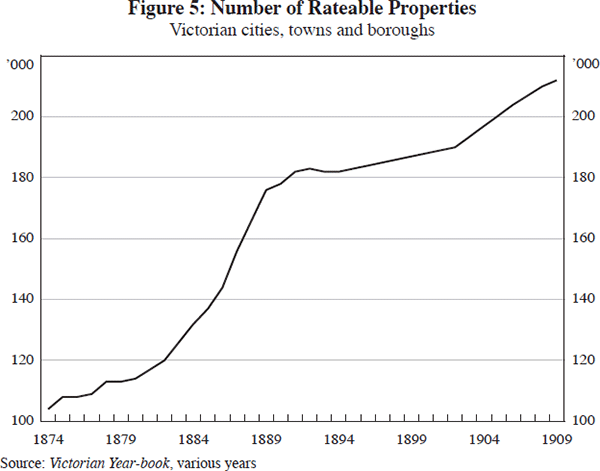
Through much of the 1880s the stock of properties was growing at around 5 per cent per year. The rapid increase in the stock of properties was, additionally, associated with large rises in the price of property. Figure 6 shows an estimate of house prices in Victorian cities, towns and boroughs over the same period.[21]
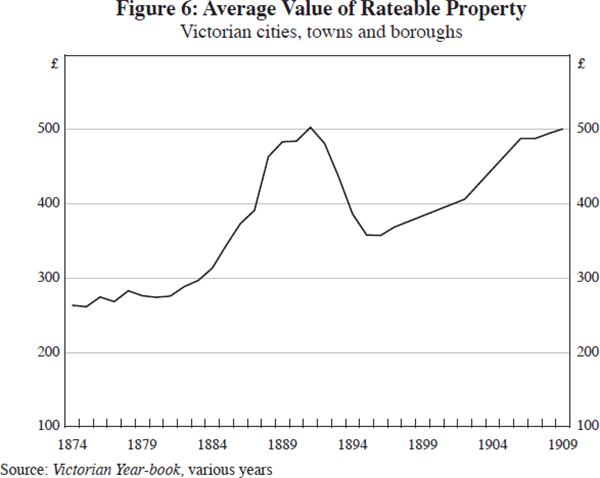
At the same time as the stock was growing at around 5 per cent per year, prices were growing at between 5 and 10 per cent per year. At its peak, in 1888, average values rose by over 18 per cent and the stock increased by 6½ per cent.
This estimate of property values, derived as it is from traditionally conservative taxation data, probably understates the growth in house prices. An alternative source is Silberberg (1975) who tracked sale prices for individual parcels of land in the suburban fringe of Melbourne – those most likely to be subject to speculative attention. Silberberg estimated that the average annual rate of return on investment in large plots of land was around 50 per cent for much of the 1880s and peaked at 78.3 per cent in 1887. These figures reflect total investment returns and, probably, the benefits of leverage. Silberberg also provides a series of average price per acre for the transactions. These grow at an average of 35 per cent per year from £40 per acre in 1882 to £335 per acre in 1889 with a peak growth of around 50 per cent in 1885 and 1887.
Even higher growth rates can be found in Cannon (1966). He reports properties in downtown Melbourne being resold for double the original price within a few months. Even on the outskirts of the city there was impressive appreciation; land in Surrey Hills is reported to have increased from 15s a foot in 1884 to £15 a foot in 1887.[22] These reports, focusing on individual properties, undoubtedly represent the most excessive transactions and, as such, would be much greater than the average. Nonetheless, they serve to provide some of the flavour of the times. The prices reported in Cannon, to the extent that they were accurate, were drawn from contemporary newspaper reports. As such, they would have undoubtedly been talking points among people during the times in the same way that remarkable real estate transactions get discussed around dinner tables today.
This rapid expansion was not going unnoticed – far from it. Accounts of the period suggest that land speculation affected most members of society. Cannon suggests that most members of parliament were engaged in land speculation and, by influencing where railway and tramway lines would be built, using political power for private gain. Indeed, because parliamentary salaries were low, independent means, which invariably meant substantial property holdings, were required to get elected and serve in parliament in the first place.
Concurrent with the land boom, a boom in share prices was also unfolding. Originally focused on mining companies, the share boom quickly embraced tramway companies as well as land banks. Edward Shann (1948) commented ‘The bubble reached its iridescence in 1888 … Its most sensational phases were the speculative dealings of the big men in city land and in mining and “investment” shares’. Cannon presents figures that show that in 1888 two-thirds of the new companies incorporated (by capital issued) were involved in land and finance activities. The reports of the share market bear a striking similarity to those related to the Poseidon boom almost a hundred years later. From the Illustrated Australian News:[23]
You only had to issue a prospectus which contained the magic words Broken Hill, and draw some lines on a piece of paper and say it was a plan showing the lode to run ‘right through the centre of this valuable property’, and that certain wonderful assays had been made, and an eager frantic public was ready to subscribe £50,000 or £100,000 in half an hour; and next morning the stock was launched upon the market and snapped up at 100, or even 500, per cent premium.
While strong demand and technological innovations started the boom, its progress was spurred by large increases in lending, particularly by so-called, land banks. Land banks were financial institutions that, in addition to lending money on the security of urban land, invested in land on their own account. Investing on their own account turned many of these banks into purely speculative endeavours. The land banks were also closely related to the frauds that proliferated at the peak of the bubble. In many cases the directors of land banks enriched themselves by misappropriating depositors' money.
3.2 The crash
The crash began in 1891. Land values fell to levels around one half their boom levels. In addition to the picture given by Figure 6, data on individual suburbs are available. In Prahran, prices peaked at an average of over £1,000 per property in 1888 and fell to £520 by 1898. Similarly, in Brighton, average property values peaked at around £950 in 1888 and then fell to around £400 in 1893 and £300 in 1898. A comparison of these data to the accounts in Cannon (1966) suggests that the picture is fairly accurate but may understate the speed of the bust. For example, Cannon writes that, ‘by the end of 1891 the bottom had completely dropped out of the land market … In Collins Street, sites for which £2,000 a foot had been rejected a short time before, were now being offered for £600 a foot – and could not find buyers even at that price’ (Cannon 1966, p 18).
The exact trigger for the crash is unclear. Nonetheless, its general nature is fairly clear. From the end of 1887 many reputable banks restricted their lending for land purchase substantially. Regardless, the market continued to grow for another four years largely supported by the activities of the land banks. Many of these financial institutions were obtaining money on deposit from the UK by offering higher interest rates than were available on other investments; foreign investors did not seem to factor in the likelihood of default in making these deposits.[24] However, fundamental factors were beginning to affect the bubble. The huge amount of land that had been brought onto the market meant that rental yields were depressed. Furthermore, the low rental yields combined with high leverage meant that speculators were experiencing increasing cash flow problems. Mortgage defaults and bank runs eventually led to a number of financial institutions going under. This then started a chain of events that led to the bubble completely deflating. Many of the land banks had only recently been floated and had issued partly paid shares. In an effort to continue operating they issued calls for the remainder of the capital, which, in turn, required shareholders to sell land to meet the call on their shares. The additional selling pressure pushed prices down significantly, thereby inducing further financial problems. This then became a full-blown financial collapse, which led into a more general depression.
The population of Greater Melbourne declined from 490,000 in 1891 to 458,000 in 1897 as people sought better opportunities elsewhere. Nonetheless, Victoria was not unique and many other areas experienced depressed conditions. A full examination of the financial crisis and depression are beyond the scope of this paper but an interested reader may wish to consult Fisher and Kent (1999) for a more detailed discussion.
One positive outcome from the bubble and its collapse was an improvement in the legislation governing corporate conduct. The collapse in the land boom induced a change in government as many leading politicians were implicated in the financial scandals. The new government introduced a number of bills designed to raise standards of corporate conduct. The old law, the Victorian Companies Act of 1864, had many loopholes that could be exploited by entrepreneurs to engage in unethical but legal activities designed to enrich themselves. Many of these loopholes were closed in the amended legislation – although Cannon reports that opposition from the Upper House restricted the scope of changes.
The mining boom of 1969–70 developed into a form of mass hysteria. This may be deplorable, but until we can change the fundamentals of the human psyche, people will be prone to mass hysteria occasionally and the stock exchange is probably the most harmless outlet for it.
After all, it's only money.
(Sykes 1978, p 373)
4. The Poseidon Bubble
Mining is an inherently risky enterprise. Exploration is even riskier. While geologists can highlight the more likely areas for minerals exploration, until a drill is put into the ground, nothing can be known for certain. In this environment it is not uncommon for the stocks of exploration companies to show high volatility. This volatility is most closely related to whether or not a drill discovers any minerals or not. It is entirely possible for a small company to multiply its value hundreds of times over on a successful strike.
In this environment it is unsurprising that share prices can boom or crash spectacularly. Nonetheless, shares experiencing both a boom and a crash in close proximity, essentially a bubble, are still a rare phenomenon. This happened to many companies in 1969 and 1970.
4.1 Background
The 1950s and 1960s have frequently been referred to as the ‘long boom’ – growth was high, and unemployment and inflation were low. Real growth from 1950 to 1969 averaged 4.5 per cent per annum. Excluding the Korean War boom, inflation averaged 2.5 per cent from 1952 to 1969. Unemployment was low, averaging 1.2 per cent over the 1950s and 1960s with a high of just 2.6 per cent in 1961.
Building on this base of solid economic fundamentals, Australia's mining sector was growing rapidly. Since the first gold discoveries Australia had been known to be rich in minerals. The full extent of those deposits was, however, unknown. The 1950s and 1960s were a period when major new mineral discoveries were being made in Australia, greatly expanding the range and size of known mineral resources. Major iron ore, uranium, bauxite and petroleum discoveries were made in this period: the Weipa bauxite mine, the Mary Kathleen uranium mine, the Mt Tom Price iron ore mine, and the Bass Strait oilfields. The growth of the ASX All Mining Index reflected the overall effect of these major discoveries on the market (Figure 7). The index grew by 25 per cent per annum, on average, over the 11 years from 1958 to 1968.
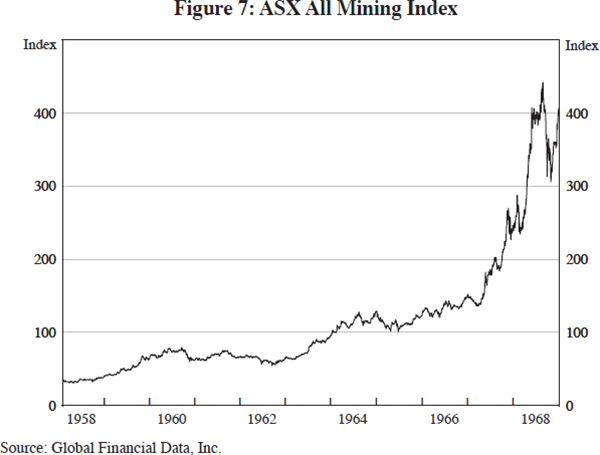
4.2 The bubble
The Poseidon bubble had its genesis in the nickel market. In the second half of the 1960s shortages of nickel were emerging. There was high demand spurred by the Vietnam War and a shortage of supply as the major Canadian producer, Inco, was embroiled in industrial action. This had seen the free price of nickel (as opposed to the controlled producer price) skyrocket (Figure 8). The free price of nickel reached a peak around £7,000 per ton on the London market at the beginning of November 1969. Poseidon came to the public's attention at just the right time.
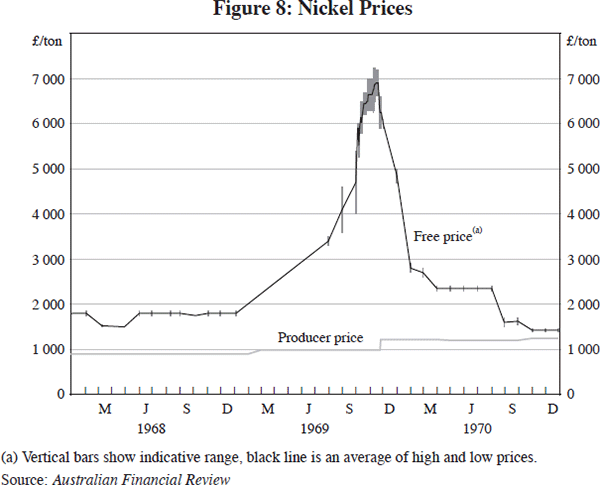
4.3 Poseidon NL
Poseidon NL (no liability) was a mining exploration company that made a major nickel discovery at Windarra in Western Australia in 1969. Poseidon had been languishing for many years before it acquired some exploration leases and hired a prospector in 1968. The exploration leases did not turn into a mine but the prospector, Ken Shirley, did find a promising site at Windarra. Poseidon's shares started rising around September 25, 1969 when results from drilling on the Windarra site became known to some insiders. Shares had been trading around $0.80 in early September and rose to $1.85 on Friday September 26. On Monday September 29 the company made a preliminary announcement that drilling had found nickel and this pushed the share price from $1.85 to $5.60. On October 1, company directors made a more detailed announcement indicating that they had a major nickel find. The share price jumped from $6.60 to $12.30 that day and then kept going up (see Figure 9).
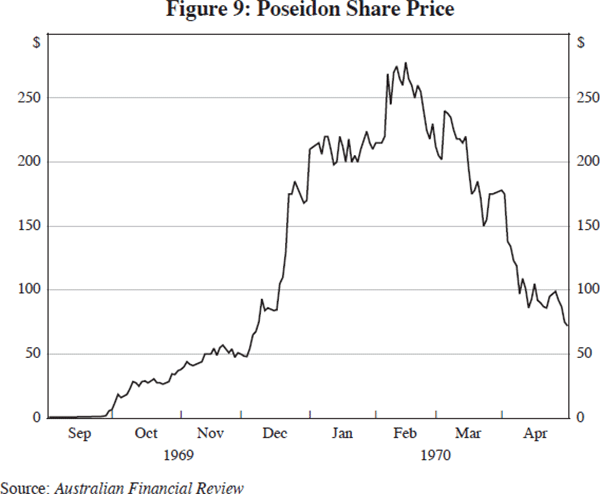
Up until this point all the share price moves can be explained on the basis of fundamentals – a small company with few shares on issue had made a major nickel discovery. The discovery made the front page of the Australian Financial Review (AFR) on October 3 with the headline ‘Nickel boom turns radioactive’. From here on it captured the public's imagination. Other mining shares started to rise as speculators took positions in nickel stocks, then companies with leases near Windarra, and miners in general. From October to December 1969 the ASX All Mining index rose by 44 per cent from 438 to 632.
The volume of trading also rose substantially, reaching over 37.9 million shares traded on November 3 (compared with a pre-bubble record under 20 million). This put a strain on the stock exchanges' newly installed computers and brokers' back offices. This only served to fuel the excitement as share prices continued to rise.
New information on the Poseidon mine came out only gradually. Around November 19 Poseidon issued another drilling report but its shares, now trading around $50, did not move appreciably. More significant price movement occurred around Friday December 19, the date of Poseidon's AGM. It closed at $110 on Thursday and had run to $175 by the following Monday. Other than these two occasions, the information that underlay market movements was scant.[25]
Calculations as to the value of Poseidon shares were many and, given the lack of solid information, varied. Sykes (1978) presents one that would have been made around the time of the bubble suggesting that Poseidon was worth about $60 a share. A letter to the editor of the AFR published on December 31, 1969 suggested that $112 a share was reasonable. In January 1970 a UK broking house published a report that suggested a value of between $300 and $382 per share would not be unreasonable, that report was summarised in the AFR on February 11, 1970. In any case, all the calculations were based on a large number of assumptions, the prime one being that the price of nickel would remain as high as it currently was, around £6,000–£7,000 per ton at the end of 1969. Most of the assumptions turned out to be false – the ore concentration was lower than assumed, the price of nickel was lower than assumed and the costs of extraction were higher than assumed.
While the run-up in Poseidon's share price was spectacular, it was at least based on a real discovery. The speculative excess in the market is much more obvious in the behaviour of other mining shares. There were a large number of listings as promoters tried to cash in on the aura surrounding mining stocks.[26] In an echo of the fabled ‘company for carrying on an undertaking of great advantage, but nobody to know what it is’ from the South Sea bubble – a number of companies floated with ‘empty’ prospectuses containing no details on any prospects.[27] Indeed, insiders managed to extract a lot of money from the boom. The AFR examined one group of promoters' profits in a front-page article ‘How to turn $1 into $12m’.[28] Sykes (1978) details the exploits of David Paxton with regard to Barewa Oil and Mining where considerable amounts of capital found its way into the promoters' pockets.
Early on in the boom Poseidon stock went out of the reach of many investors – comments to that effect appeared when Poseidon passed $50 on the way up. Instead, speculative attention focused on cheaper shares. Cashing in on this, many companies issued shares at low face values or on a partly paid basis. Barewa had issued $1 shares as well as 10 cent and 1 cent partly paid shares. Also, the mechanics of the market were such that buy orders could be made and payment not made for a couple of weeks. This encouraged people to buy on the prospect of making gains before any money was actually due, by which stage they could sell out for a large profit with no money down.
The speculative activities surrounding the fringe companies are best exemplified by what happened to Tasminex NL at the end of January 1970. Tasminex was an exploration company that was investigating some leases at Mount Venn in Western Australia. On Friday January 23, one of the directors of the company panned some drill samples and identified some heavy metals in it. This seems to have been the basis for a rumour that they had discovered nickel. Prices rose on that Friday from $2.80 to $3.30. On the next trading day, Tuesday, they rose further to $16.80 based on more rumours. Companies with leases bordering Mount Venn also began appreciating. Then, following the publication of an interview by Trevor Sykes with the company chairman, the shares hit $96 in overnight trading on the London market. In Australia the shares traded as high as $75 and closed at $40 on Wednesday. The company chairman sold many of his shares at these prices and realised a substantial profit. Thereafter, the shares trended down as no further news was forthcoming. No discovery was ever made at Mount Venn.[29]
4.4 The crash
The resources market, as measured by the ASX All Mining Index, peaked in January 1970 and Poseidon shares peaked in February.[30] Thereafter, both fell quickly and substantially. There is no clear indication of what triggered the decline but the activities of the fringe companies no doubt helped to tarnish the stock market in many people's minds. At its peak Poseidon had a market capitalisation of $700 million, which was about a third of the capitalisation of BHP (Australia's largest company) at the time. That kind of value was not bad for a company that only had one mine. The peak of the market also coincided with a series of front-page articles in the AFR outlining the shady practices of various share promoters. From this time a greater number of negative articles start appearing in the press. On March 17, before the realisation that the bubble had burst had set in, a seminar criticising the mining boom was reported in the AFR (p 18). Dr John Rose of Melbourne University's Institute of Applied Economic and Social Research was quoted as saying:[31]
There are increasing signs that a large and growing proportion of the amounts being raised are going into buying claims and other assets at inflated values and in paying company associates high salaries and consulting fees …
One cannot help but wonder whether the atmosphere in our stock market trading in mineral securities should not be likened to that which existed when chain letters were the rage. To put it another way, are people buying stocks on the appreciation that they will locate a valuable source of minerals and develop the mine into profitable production, or are they buying merely on the assumption that there will be further demand for the stock … and such additional demand will enable them to sell the stock at a price higher than what they paid?
On March 18 the AFR led with ‘Shares crack: quality counts – blue sky prospectors turn grey in heavy setback’. After peaking at over 640 in January 1970, the ASX All Mining index fell to around 200 in November 1971.
After the bursting of the bubble, Poseidon's share price drifted down and the business of exploiting the Windarra discovery actually got underway. The mine produced nickel beginning in 1974 but it was not enough to keep Poseidon going. After experiencing many difficulties Poseidon delisted in 1976. The Windarra mine was taken over by Western Mining and operated until 1991 when it was shut down. This is in contrast to the majority of other stocks associated with the bubble – these never even had a viable mine, some didn't even have mining leases.
The Rae Committee report, handed down in 1974, documented the abuses that had gone on during the Poseidon boom.[32] The report highlighted how the stock market had been poorly regulated and that much of the information relied upon by investors was uncorroborated rumour. It recommended a number of changes to financial regulation and the regulation of stock markets which would, presumably, prevent the sort of abuses that occurred during the Poseidon boom from happening again.[33]
With the benefit of hindsight, it is possible to make an estimate of what the Poseidon mine was really worth. Over its life, Windarra produced 5.4 million tons of ore with an average grade of 1.5 per cent nickel. Assuming an average price of $3,000 per ton for nickel makes the ore body worth about $250 million. From this must be subtracted capital and labour costs. Given the relatively low ore grade, the extraction costs were very high and, thus, the mine was no more than a break even proposition. Nonetheless, this information was unknown in 1969 and 1970 so it was certainly rational to put a positive value on Poseidon shares. The bubble came when that value of Poseidon was pushed to $700 million.
Greed is all right, by the way. I want you to know that. I think that greed is healthy. You can be greedy and still feel good about yourself. Ivan Boesky, Commencement address, UC Berkeley School of Business, May 1986
5. The 1987 Stock Market Bubble
Stock markets appear to be the most frequent environment where bubbles occur, and are certainly the most intensively studied. Stock markets are very close to the idealised, frictionless markets of economic theory. Turnover costs are low and there are also a wide variety of derivative products available, including futures markets.[34] In this regard, bubbles in stock markets are difficult to reconcile with economic theory. Theory predicts that the market price of a stock will accurately reflect all available information and that departures from fundamentals should be arbitraged away by rational traders. Despite this, there are numerous episodes where stock markets display apparently irrational behaviour. Abstracting from whether the behaviour is rational or not, the Australian stock market in the late 1980s displayed some strange behaviour.
5.1 The 1980s
The 1980s were a period of relative optimism after the stagflation and economic disruption of the 1970s. In the UK and US Margaret Thatcher and Ronald Reagan were elected and their economic policies helped to promote a favourable environment for ‘capitalists’. In Australia, while inflation remained above the OECD average, there were numerous economic policy reforms that gave people reason to expect an improvement in economic conditions. After the recession in the early 1980s unemployment and inflation were generally falling.
One of the most significant changes to take place was general financial deregulation. Interest rate ceilings on banks were lifted in 1980, the Australian dollar was floated in 1983 and foreign banks were granted full banking licenses in Australia in 1985. Other restrictions were relaxed and loans became much more freely available. The entrance of foreign banks also spurred competition and banks sought ways to expand their lending operations to maintain or expand market share. The primary recipient of this lending was the business sector (Figure 10).
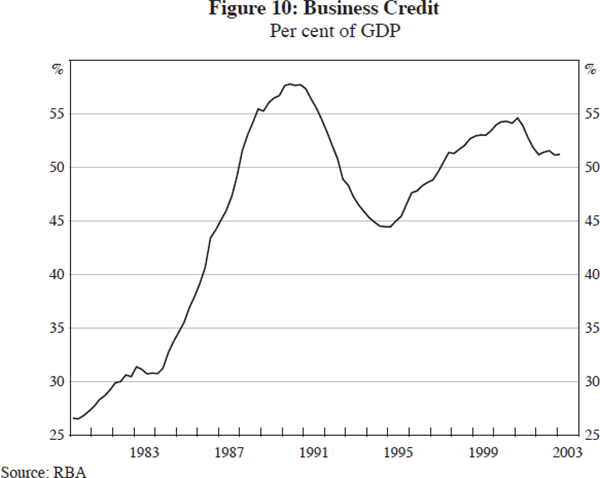
The increase in credit available to the business sector fuelled expansion in corporations and increased takeover activity. The easy availability of credit led to a strong increase in the gearing levels of many companies. Figure 11 shows the overall gearing of listed non-financial Australian companies. The black line shows the gearing of companies operating in 1988. The grey line shows the gearing of companies operating today.
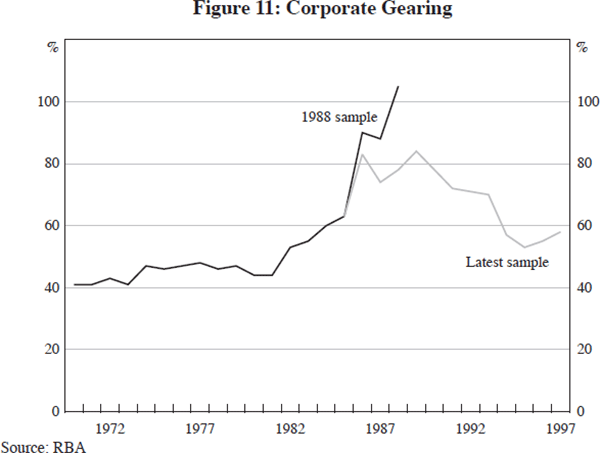
The level of corporate gearing increased rapidly in the 1980s to over 100 per cent on average from below 50 per cent. As the later sample shows, the companies with the highest gearing, on average, are no longer in the sample. This suggests that these companies went out of business because of the high debt levels they accumulated. This was certainly the case for Quintex and the Bond group of companies.
The increased liquidity seen in Australia was part of a worldwide pattern. In the US, the growth of the stock market was being fuelled by leveraged buy-outs (LBOs). LBOs involved companies being taken over with a high degree of debt financing. The debt was obtained through the issue of ‘junk bonds’ – bonds with high default risk. While LBOs were not as common in Australia, there was, nonetheless, a large use of debt secured against shares to finance business activities in Australia. The prevalence of LBOs led to company valuations being based not on the company's underlying prospects, but on the level of debt it could support given its cash flows:
Nowadays, more and more analysts are valuing stocks based on cash flow rather than earnings. When Coca-Cola spun off its largest bottler in an initial public offering of stock in late 1986 at 110 times earnings, analysts explained away its rich price to investors using the cash-flow thesis. The earnings weren't great, so the story went, but the company did generate buckets of cash. Therefore, the stock looked cheap. Just figure you're buying it for five times cash flow. The argument makes some sense, but it is one more example of how people tend to stretch standards as bull markets progress in order to justify further advances.
(Morgenson 1987, p 110)
The outworking of this financial relaxation and the new business methods is best typified by the cases of Alan Bond, Christopher Skase and the merchant banks Tricontinental and Rothwells. The 1980s saw the rise to prominence of a number of ‘entrepreneurs’ who expanded their business empires rapidly through the use of debt provided by Australian financial institutions. The debt was typically used to take over other businesses. The most aggressive of these financial institutions were Tricontinental – the merchant banking arm of the State Bank of Victoria – and Rothwells – another merchant bank. These merchant banks made very risky loans and were major financers of both Skase's Quintex group and the Bond group. Don Argus, CEO of the National Australia Bank, summed up the experience:
It is fair to say that in the late 1980s banks paid inadequate attention to pricing for risk. This was partly because we were on a fairly steep learning curve after the shackles of regulation were removed. We were also faced with a scramble for market share by new bank entrants and by State banks which were vigorously – and some may observe disastrously – trying to turn themselves into commercial banks virtually overnight.
(Argus 1991)
The heavy use of leverage was not, however, fully recognised at the time. Entrepreneurs obtained their funding from large syndicates of banks, each taking a small part of the overall exposure. Immediately after the crash, Skase's Quintex group was lauded as having escaped the crash and being relatively debt-free.[35] While Bond Corp was recognised as a highly geared company, a restructuring just before the crash was seen as having dealt with many of the company's vulnerabilities.[36] The Age carried an article on this titled ‘Bond Corp's lower debt burden shows virtue in being a stayer, not a sprinter’.[37] In both cases, the true level of gearing was not recognised. The debt was typically disguised in various accounts and distributed across a group of companies to hide the true picture.
The spirit of the times also encouraged a very cavalier attitude among merchant banks (and even some traditional banks). Tricontinental had no prudential controls to speak of and made loans without seeking proper security or credit checks. Many of its loans were secured against shares in the borrowing company – if the company had problems paying its debts, the shares were going to be worthless as well. Rothwells was also lending to the most speculative entrepreneurs without sufficient security – Laurie Connell, a director of Rothwells, was known as ‘last resort Laurie’ for his willingness to lend to entrepreneurs other financial institutions had rejected.
Asset prices rose strongly in this environment. From January 1985 to January 1987 the All Ordinaries index doubled with an average annual growth rate of over 40 per cent. From January 1, 1987 to September 21, when the market peaked, the stock market rose by 56 per cent to reach 2,306. Stock exchanges around the world experienced similar rises – the UK, Japanese and US indices all rose by over 40 per cent from January 1, 1987 to their peaks.[38] At its peak, companies listed on the Australian Stock Exchange were trading at a price-earnings ratio of over 20 – the highest on record for the Australian market. One justification for these rises was summed up in a Forbes magazine article:
The most vociferous bulls are those who claim the world is so awash in uninvested cash waiting to be deployed in the stock market that share prices can only go higher. Just look at all those dollars—IRA money, Japanese money, pension money, even home equity money. Where else besides the stock market can it go? (Morgenson 1987, p 110)
In a familiar sign of a bubble there was a growing trend towards ‘cash-box’ companies ‘in which over-keen investors simply give their cash to someone with a reputation for making a fast buck’.[39] These companies were just like the ‘empty’ prospectus companies of the Poseidon boom and the ‘company for carrying on an undertaking of great advantage, but nobody to know what it is’ from the South Sea bubble.
Throughout 1987 there were warnings about the strength of the market. In March 1987, Rene Rivkin was interviewed by Australian Business magazine and said ‘I have to be irrational now to make assessments because the market has gone beyond all reason’.[40] In April PD Jack wrote ‘As the market climbs ever higher the inevitable day of reckoning comes ever closer. The market will fall but we don't know when. In the meantime there's still money to be made’.[41] In October, immediately before the crash, Trevor Sykes commented, ‘On fundamentals such as net tangible asset backing and price-earning multiples, there is hardly a stock on the boards worth buying. But many are still going to rise and the trick is to pick the runners in the market’.[42]
This all suggests that many people involved with the share market recognised how speculative the share market values had become. Nonetheless, the Business Review Weekly summed up the prevailing sentiment in September 1987, barely a month before the crash, ‘Most agree that the share market still has a considerable way to go and those investors who sell now could miss out on one of the strongest phases of the bull run’.[43]
Right up to the end of the bubble, the optimists were conspicuous. Following a fall of 4.6 per cent on Wall Street on Friday October 16, The Sydney Morning Herald of Monday October 19 carried the story ‘Market ready for slide … but the brokers maintain the long bull run is far from finished’ (p 33). The paper quoted Nestor Hinzack of Ord Minnett saying ‘We are looking for a correction. I then believe we are in for another leg in the bull market, and I think that leg could well take us into the early part of 1988’. As it turned out, they were wrong.
The crash in the stock market was initiated in the US and quickly spread around the world. There was no clear reason for the US market to fall and the only reason for the Australian market to fall was that the US had fallen. On October 20, the Australian market fell by 516 points or around 25 per cent. It continued to fall for the next couple of weeks before troughing at 1151 on November 11 (Figure 12). In all, the market fell by 50 per cent from its peak.[44]
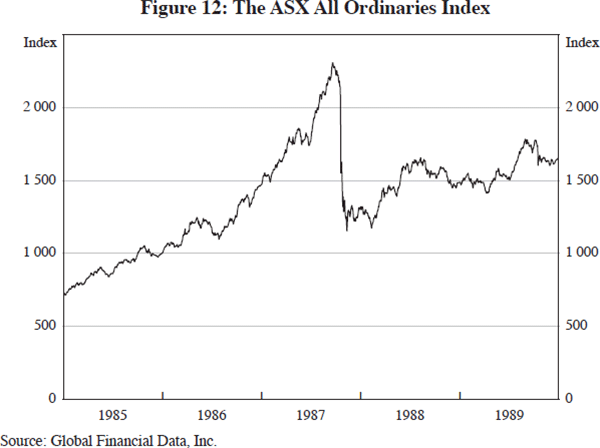
One of the first casualties of the stock market crash was Rothwells. Because of its heavy exposure to the speculative end of the market the crash led to a run on the merchant bank. Alan Bond organised a rescue package in conjunction with the West Australian Government, but, ultimately, the merchant bank failed because it had lent to very speculative enterprises.
In the following years many entrepreneurs who had expanded rapidly in the bull market went under. In the process a number of financial institutions went bankrupt or came very close. Both Christopher Skase and Alan Bond's empires collapsed under the heavy debt burden they had built up. At the time of the October 1987 crash, Bond group had borrowed $392 million from Tricontinental with $285 million of that secured against Bond Corp shares.[45] This compares with the merchant bank's capital base of around $100 million. Tricontinental and the State Bank of Victoria were eventually absorbed by the Commonwealth Bank. As with most previous bubbles there was a large amount of fraud revealed after the crash. Most of the high-flying entrepreneurs of the 1980s ended up with tarnished reputations and several were convicted of various frauds. However, in general there was no severe recession associated with the bursting of the stock market bubble despite the fall being larger than the 1929 share market crash in Australia.
5.2 A second wind: property
While the overall consequences of the stock market crash were remarkably mild, there was one more element of the 1980s bubble to be played out. Property, and in particular, commercial property, boomed after the stock market crash. There had been an element of ‘hedging’ driving up property prices before the crash: ‘When the share bull run ends the smart players will have already moved on – many into that classic haven, real estate. The property market is set to move’.[46] But the most spectacular growth occurred after the share market crash. Figure 13 shows commercial property values in a number of cities around the country.
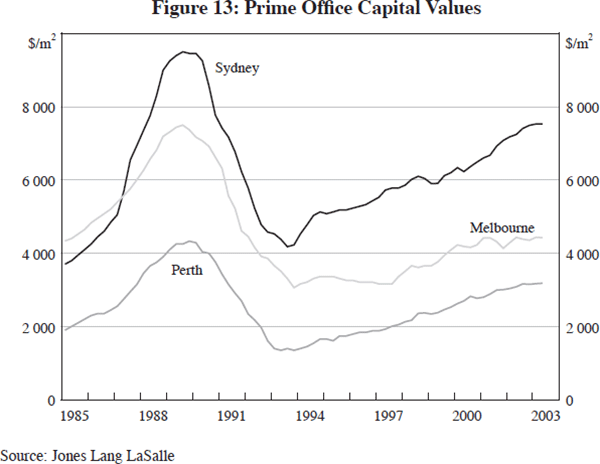
In Sydney, prices soared to around $9,000 per square metre from below $4,000. This boom was propelled by the large switch of investors away from shares into property after the October crash. This was summed up by an article in Australian Business in March 1988: ‘And one of the simplest truths obscured by half a decade of share madness was that any worthwhile portfolio needs a core of quality long-term assets. Investors are now quickly re-learning that real estate is an indispensable part of this core’. The bubble was supported by banks' continued easy lending practices. As seen in Figure 10, credit to GDP continued rising after the stock market crash and only reached its peak in 1990. In sum the commercial property bubble occurred for the same reason as the stock market bubble – too much money chasing too few assets.
However, the commercial property bubble inevitably burst, and when it did property values halved. In Melbourne and Perth, property values in 1993 were below their 1985 levels while in Sydney values were only slightly above their 1985 level. The commercial property boom ended for pretty much the same reason that most land booms end – supply increased and rental returns couldn't support the prices being paid. This was particularly true of highly-leveraged investors who faced higher and higher interest rates over this period as monetary policy was progressively tightened. This can be seen clearly through figures for prices, rents, construction and vacancies in Sydney (Figure 14).[47]
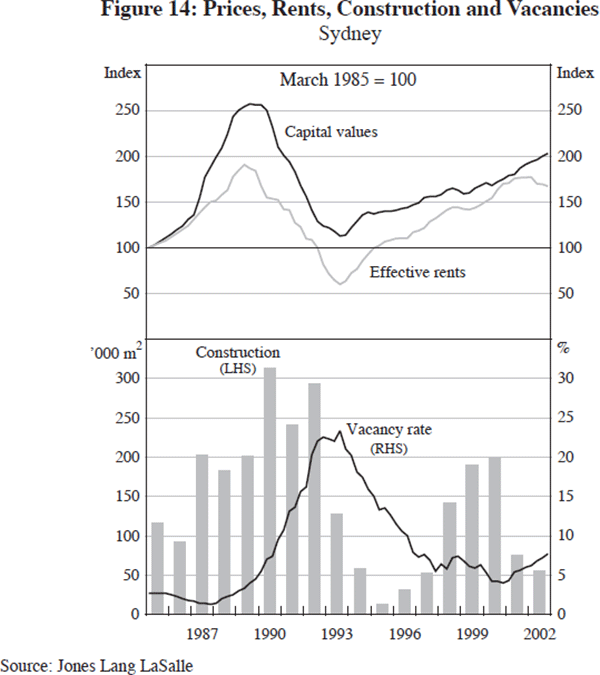
The collapse in the commercial property bubble, coinciding with a recession, was actually associated with greater financial distress than the earlier share market bubble. Two of the largest banks in Australia experienced significant losses as a result of their exposure to bad debts from failed commercial property developers. The banking sector as a whole had very low returns on shareholder funds through 1990, 1991 and 1992 and generated a negative return on shareholder funds in 1992.[48] While Tricontinental and Rothwells were peripheral to the Australian financial system, the banks affected by the commercial property bubble collapse were at its centre. In this respect the commercial property bubble had greater financial consequences than the share market bubble.
The share market bubble, thus, had a feature not seen in the other Australian bubbles – a second wind. The share market crash did not lead to an immediate reduction in credit availability. Furthermore, the real economy was barely affected by the share market crash. Thus, the conditions that supported the stock market bubble remained in place and people's speculative enthusiasm was barely diminished. It was only when the commercial property bubble burst that the 1980s speculative enthusiasm could be considered finally ended.
6. Discussion and Conclusion
The bubbles discussed above all fit the definition of Section 2.2 closely. In each, the prices of shares or property rose spectacularly before falling just as spectacularly. In each case there was a fundamental reason for the initial rise: the rapid growth in the population of Melbourne, combined with the technological developments that made suburban living more amenable; the discovery of nickel at Windarra in Western Australia; and financial deregulation in the 1980s. Nonetheless, on each of these occasions the initial reasons for investing were subsumed by a general desire to buy assets for purely speculative reasons.
In addition to the similarity of price movements, each of the episodes occurred in an environment of general optimism. In each there was also a surge in company formation, and while some of these company formations were merely opportunistic, others were fraudulent. In the Poseidon bubble and the late 1980s bubble there were actual examples of ‘compan[ies] for carrying on an undertaking of great advantage, but nobody to know what it is’. However, we have also seen a number of the elements that are commonly, but not necessarily, associated with bubbles. Credit was clearly a factor in the Melbourne land boom and the late 1980s bubble, however, it was not prominent during the Poseidon bubble. New technology was significant in the Melbourne land boom but not in the other two episodes.
It might be hoped that these common features could be used as early warning signs that a bubble was emerging. Hindsight, however, has many benefits; and the ability to clearly spot a bubble seems to be one of them. For example, while fraudulent activity is very common during a bubble, it is typically not revealed until later. Nonetheless, assuming bubbles can be identified early, there are a number of questions for policy. Other papers in this conference address many of these so I will not dwell on them here. Instead, I offer a comment on how the rationality (or otherwise) of bubbles relates to the conduct of policy.
Within the bubble literature there is a branch that deals with the possibility that bubbles could be perfectly rational.[49] This theory proposes that people are fully aware that the market has departed from fundamentals but invest anyway because the profits from being in the bubble outweigh the risk associated with it bursting. There are also economists who believe that ‘bubbles’ are rooted in fundamental changes, in essence, that there are no true bubbles. If either of these situations are in fact the case, there is less force to arguments that action of some sort is required – after all, people are fully informed and behaving rationally.[50] However, regardless of whether the bubbles examined in this paper were, or were not, ‘rational’ or fundamentally based, they had significant consequences. In this respect, it is not crucial whether bubbles are rational or fundamentally based – the fact that they have significant consequences is reason enough for policy-makers to be concerned.
Appendix: Historical Data
The data on Melbourne house prices comes from the Victorian Year-books of the time. These record the total value of rateable property and the number of rated properties for Victorian cities, towns and boroughs in a given year. Dividing one by the other gives an estimate of the average value of houses. The data for number of rateable properties was obtained through censuses in 1881 and 1891 and estimation during intervening years. In 1887 Greater Melbourne accounts for 73 per cent of the population of Victorian cities, towns and boroughs and over 83 per cent of the value of rateable property.[51]
The rates information was collected because land tax represented the major source of government revenue at that time. Given its central role in government revenue one might expect the estimates to be reasonably accurate. The estimates do not, however, show the same degree of price fluctuations that are available in some reports of the times that refer to specific properties. Nonetheless, this is to be expected as there would always be particular properties that were mentioned precisely because they were outliers. As this data refer to the entire stock of property, such extreme price swings would not be expected. Importantly, this data is likely to be more accurate than the contemporary equivalent, land tax assessments.
One of the interesting things about the data from this time is that it becomes incomplete immediately following the bust. No Year-book was produced for 1891–92 and annual Year-books ceased being produced altogether in 1894. Their production was only resumed in 1902 with a much reduced quantity of data. The reason was that the Government Statist at that time, Henry Hayter, was in serious financial trouble in 1891, and finally declared insolvency in 1894 when he retired from his position as Government Statist.[52]
Footnotes
I would like to thank Simon Guttmann for valuable research assistance. I would also like to acknowledge Michael Cannon and Trevor Sykes, whose books on the Melbourne land boom and Poseidon bubble proved invaluable resources. Tony Richards, Luci Ellis and seminar participants at the RBA provided useful comments. [1]
See Garber (1990). [2]
See Siegel (2003). [3]
Section 2.2 provides more details about the relevant literature. [4]
See Mackay (1980, pp 46–88) and Chancellor (1999, pp 58–95) for further details. [5]
The only trade allowed was to provide slaves to the Spanish colonies and one general trade ship per year of a restricted tonnage and cargo value from which the King of Spain, in any case, took a substantial cut of the profits. [6]
The source of the money to fund the higher dividend was not made clear. [7]
See Mackay (1980, p 55) and Chancellor (1999, p 72) on this particular South Sea bubble company. [8]
See Chancellor (1999, pp 122–151) for more details. [9]
Chancellor (1999, p 130). [10]
A letter in The Times, 12 July 1845 – quoted in Chancellor (1999, p 136). [11]
See Chancellor (1999, pp 191–232) and White (1990) for more details. [12]
Chancellor (1999, p 194), provides a summary of the relevant work (EL Smith (1924), Common stocks as long term investments, McMillan, New York) and its effect on investors at the time. [13]
At the end of 2001 the difference had fallen to 15 per cent because of the fall in Amazon's market capitalisation to US$4 billion and a rise in the market capitalisation of Borders and Barnes and Noble. [14]
Because the S&P 500 included a number of tech stocks it would also have been affected by the bubble. Thus, this figure should not be seen as quantifying the size of the bubble in any way. [15]
Ofek and Richardson (2003) suggest that the collapse was triggered by the expiration of lock-up clauses that allowed insiders to finally sell their stock. [16]
Details of this exercise are available on request. [17]
These suburbs are located between 2 and 6 kilometres from downtown Melbourne. [18]
These suburbs are all located around 5 kilometres from downtown Melbourne. [19]
This is dominated by Greater Melbourne, which makes up around 75 per cent of the number of properties. Rateable properties were defined as: ‘All contiguous pieces or parcels of land occupied by the same person or persons must be reckoned as only one property; but every house constitutes a separate property together with all land attached thereto’. (Victorian Year-book 1895–98, p 106) [20]
Once again, this is dominated by Greater Melbourne, which makes up around 80 per cent of the value of properties. More details on the construction of the data are contained in Appendix A. [21]
There are 20 shillings to a pound. A foot was a measure of street frontage for a standard length block. [22]
Quoted in Cannon (1966, pp 49–50). [23]
This element, speculation being supported by less informed investors in the UK, also appeared in the Poseidon boom. Many speculative mining companies had their most active trading, and largest price increases, on London markets – see Sykes (1978, pp 64–70) for a discussion of this. [24]
And, of the information released by Poseidon, much was later found to be inaccurate. [25]
Just as promoters tried to cash in on the dot com boom at the end of the 1990s. In a curious echo, many of Australia's dot com companies were languishing mining exploration companies (or shells) that went dot com to cash in on the Internet boom. [26]
The AFR, February 16, 1970, listed Basin Oil, Pursuit, Ashburton, Weatherly and Barewa as companies that had issued prospectuses with no specific prospects. [27]
AFR February 17, 1970. [28]
Chapter 12 of Sykes (1978, pp 161–174) provides more details about this episode. [29]
On February 5, 1970 Poseidon reached $280 in intraday trading but closed at $269. The peak in its closing price was $278 on February 13. [30]
Dr Rose went on to play an important role in the Rae Committee hearings into the regulation of Australian securities markets, serving as an informal advisor to Senator Rae and an economic advisor to the committee. [31]
Senate Select Committee on Securities and Exchange (1974). [32]
Insider trading, for example, was not illegal during the Poseidon boom. [33]
Futures markets operated at the time of the Dutch tulip mania in 1636. [34]
P Gardiner, ‘Skase: Behind the baby blue façade’, Australian Business, November 4, 1987, pp 28–32. [35]
Around $510 million of the $1.76 billion package for Bond Brewing's restructuring came from junk bond merchant Drexel Burnham Lambert, i.e., Michael Milken's company – quite telling given later developments. [36]
The Age, October 12, 1987, p 32. [37]
The Dow Jones rose by 41 per cent, the Nikkei by 42 per cent and the FTSE by 45 per cent. [38]
Tim Treadgold, ‘Here we go again!’, Business Review Weekly, March 20, 1987, p 51. [39]
Trevor Sykes, ‘How Rivkin plans to beat the crash’, Australian Business, March 18, 1987, p 51. [40]
PD Jack, ‘Making money’, column in Australian Business, April 29, 1987, p 77. [41]
Trevor Sykes, ‘Stick with the trend, friend’, in ‘Riding the bull market’, Australian Business, October 14, 1987, p 73. [42]
Tony Gray, Paul Luker, Julietta Jameson and Eric Ellis, ‘Crash of '88: share pessimists' stategies for another 1929’, Business Review Weekly, September 11, 1987, p 48. [43]
This fall was larger than on any other major stock exchange. The Nikkei 225 fell by around 20 per cent, the Dow Jones and FTSE 100 fell by around 35 per cent. The Australian market also took longer to regain its bubble high than other markets. [44]
Armstrong and Gross (1995, p 123). [45]
J Bruce, ‘Property: the next boom’, Australian Business, June 10, 1987, p 60. [46]
The data are similar for other capital cities. [47]
See Gizycki and Lowe (2000, p 182). [48]
See, for example, Blanchard and Watson (1982). [49]
Eugene White (1990, p 240) summarised the sentiment thus, ‘If stock market bubbles are, for the most part, a reflection and reaction to underlying changes in the economy, then the correct policy is simply to let them run their course, however distressing this may be to individual investors’. [50]
Greater Melbourne is defined as the area within 16 kilometres of the GPO. [51]
He reached a secret composition with his creditors that meant he was not publicly declared bankrupt. [52]
References
Argus D (1991), ‘Bank strategic outlook for the 1990s’, paper presented at the 3rd Australian Institute of Bankers Banking and Finance Conference, Melbourne, 1–2 July.
Armstrong H and D Gross (1995), Tricontinental: the rise and fall of a merchant bank, Melbourne University Press, Melbourne.
Blanchard O and M Watson (1982), ‘Bubbles, rational expectations and financial markets’, in P Wachtel (ed), Crises in the economic and financial structure, D.C. Heath, Lexington, pp 295–315.
Cannon M (1966), The land boomers, Melbourne University Press, Melbourne.
Chancellor E (1999), Devil take the hindmost: a history of financial speculation, Farrar, Straus and Giroux, New York.
Cooper MJ, O Dimitrov and PR Rau (2001), ‘A rose.com by any other name’, Journal of Finance, 56(6), pp 2371–2388.
DeLong JB and A Shleifer (1991), ‘The bubble of 1929: evidence from closed-end funds’, NBER Working Paper No 3523.
Fisher C and C Kent (1999), ‘Two depressions, one banking collapse’, Reserve Bank of Australia Research Discussion Paper No 1999-06.
Flood RP and RJ Hodrick (1990), ‘On testing for speculative bubbles’, Journal of Economic Perspectives, 4(2), pp 85–101.
Garber PM (1990), ‘Famous first bubbles’, Journal of Economic Perspectives, 4(2), pp 35–54.
Gizycki M and P Lowe (2000), ‘The Australian financial system in the 1990s’, in D Gruen and S Shrestha (eds), The Australian economy in the 1990s, Proceedings of a Conference, Reserve Bank of Australia, Sydney, pp 180–215.
Kindleberger CP (2000), Manias, panics and crashes: a history of financial crises, John Wiley & Sons, New York.
Mackay C (1980), Extraordinary popular delusions and the madness of crowds, Harmony Books, New York. Originally published in 1841.
McGrattan ER and EC Prescott (2001a), ‘The stock market crash of 1929: Irving Fisher was right!’, Federal Reserve Bank of Minneapolis Staff Report No 294.
McGrattan ER and EC Prescott (2001b), ‘Taxes, regulations, and asset prices’, Federal Reserve Bank of Minneapolis Working Paper No 610.
Miller MH (1990), ‘The crash of 1987: bubble or fundamental?’, in SG Rhee and RP Chang (eds), Pacific-Basin capital markets research, North-Holland, Amsterdam, pp 27–40.
Morgenson G (1987), ‘A checklist for stock market prognosticators’, Forbes, 4 May, p 110.
Ofek E and M Richardson (2003), ‘DotCom mania: the rise and fall of Internet stock prices’, Journal of Finance, 58(3), pp 1113–1137.
Rappoport P and EN White (1991), ‘Was there a bubble in the 1929 stock market?’, NBER Working Paper No 3612.
Santoni GJ and GP Dwyer (1990), ‘Bubbles or fundamentals: new evidence from the great bull markets’, in EN White (ed), Crashes and panics: the lessons from history, Dow Jones-Irwin, Homewood, pp 188–210.
Senate Select Committee on Securities and Exchange (1974), Australian securities markets and their regulation, Australian Government Publishing Service, Canberra.
Shann E (1948), An economic history of Australia, Cambridge University Press, Cambridge.
Shiller RJ (1981), ‘Do stock prices move too much to be justified by subsequent changes in dividends?’, American Economic Review, 71(3), pp 421–436.
Shiller RJ (2003), ‘Diverse view on asset bubbles’, in WC Hunter, GG Kaufman and M Pomerleano (eds), Asset price bubbles: the implications for monetary, regulatory, and international policies, MIT Press, Cambridge, Mass, pp 35–39.
Siegel JJ (2003), ‘What is an asset price bubble? An operational definition’, European Financial Management, 9(1), pp 11–24.
Silberberg R (1975), ‘Rates of return on Melbourne land investment, 1880–92’, Economic Record, 51, pp 203–217.
Stiglitz JE (1990), ‘Symposium on bubbles’, Journal of Economic Perspectives, 4(2), pp 13–18.
Sykes T (1978), The money miners: Australia's mining boom 1969–1970, Wildcat Press, Sydney.
Warman PC (1990), ‘Comment on bubbles or fundamentals?’, in EN White (ed), Crashes and panics: the lessons from history, Dow Jones-Irwin, Homewood, pp 224–227.
White EN (ed) (1990), Crashes and panics: the lessons from history, Dow Jones-Irwin, Homewood.
Wigmore BA (1985), The crash and its aftermath: a history of securities markets in the United States, 1929–1933, Greenwood Press, Westport.